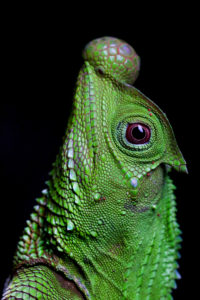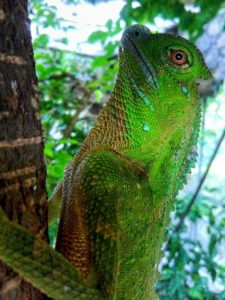 DESCRIPTION: Genus Lyriocephalus is a genus that endemic to Sri Lanka and it has only one species called Lyriocephalus scutatus. The largest agamid lizard of Sri Lanka. L.scutatus is commonly known as Lyre-headed Lizard or Hump-nosed Lizard. The reason for those names is having a globular, knob-like rostral appendage. And also they have a highly developed, terminally pointed supraciliary ridge above eyes. They are the distinguishing characteristics from other Agamid lizards in SriLanka. Body colour highly changeable from dark to light green, especially in males Hatchlings a juveniles grey-brownish. Commonly found in tree trunks up to 10m high in shaded areas. Usually non-aggressive. They have the ability to change the body colour green to dark brown. When threatened, they usually try to climb higher and sometimes display their bright red coloured mouth. Diurnal, arboreal and slow-moving species. Lay eggs during the rainy seasons. The largest threat that they are facing in the wild is habitat loss.
DESCRIPTION: Genus Lyriocephalus is a genus that endemic to Sri Lanka and it has only one species called Lyriocephalus scutatus. The largest agamid lizard of Sri Lanka. L.scutatus is commonly known as Lyre-headed Lizard or Hump-nosed Lizard. The reason for those names is having a globular, knob-like rostral appendage. And also they have a highly developed, terminally pointed supraciliary ridge above eyes. They are the distinguishing characteristics from other Agamid lizards in SriLanka. Body colour highly changeable from dark to light green, especially in males Hatchlings a juveniles grey-brownish. Commonly found in tree trunks up to 10m high in shaded areas. Usually non-aggressive. They have the ability to change the body colour green to dark brown. When threatened, they usually try to climb higher and sometimes display their bright red coloured mouth. Diurnal, arboreal and slow-moving species. Lay eggs during the rainy seasons. The largest threat that they are facing in the wild is habitat loss.
Diet : Arthropods such as spiders, centipedes and other insects and worms. They usually feed on insects like grass hopers, beetles,flies and moths. There are few records that they feed on leeches(Hirudo sp).
DISTRIBUTION: Widely distributed in wet and intermediate zones at 30-1,000m above sea level (Kandy, Udawatte Kale, Gannoruwa, The Knuckles Range, Pak Wilderness, Kitulgala, Sinharaja RF, Gampola, Dambulla and Ratnapura). though habitat is highly fragmented. Endemic to Sri Lanka.

Reference:
Lyriocephalus_2010





